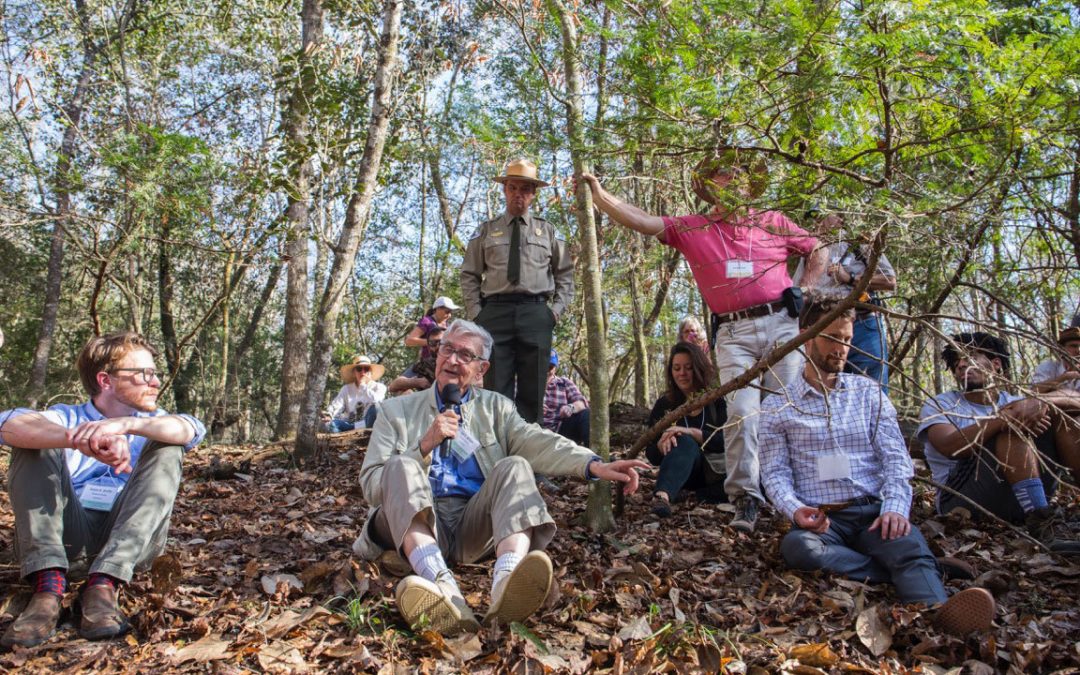For Endangered Florida Tree, How Far to Go to Save a Species?
The Florida torreya is North America’s most endangered conifer, with less than one percent of its population remaining. Now, scientists are mounting a last-ditch effort to save the torreya and are considering using new gene-editing technologies to protect it.
Edward O. Wilson clambered partway down a slope in the Florida Panhandle, aided by a park ranger and trailed by a few dozen scientists, conservationists, and local landowners. The group had gathered in Torreya State Park, a landscape of dazzling botanical diversity along the upper Apalachicola River, as part of a whirlwind two-day meeting early this month to ponder the fate of its most storied tree. As the wind gusted through leafless branches, the lanky, white-haired Wilson, at 88 years of age still one of the most brilliant biologists of his generation, planted a seedling of the Florida torreya, North America’s most endangered conifer.
Wilson first visited the Apalachicola bluffs in 1957, as a self-described “young guy” with a new position at Harvard University, on an ant-collecting trip in Florida. “I came here,” he recounted, “the way you would go to Paris to visit a cathedral. I just had to see the torreya.” The trees had already begun their steep decline.
More than 60 years later Wilson was back. This time he declared the site “is not only a cathedral, but also a battleground at which one of the greatest events in American history will take place” — a turning point, as he sees it, in the planetary struggle to slow biodiversity loss.
Last spring, another “young guy” was at Torreya State Park on a camping trip with his lab. University of Florida forest pathologist Jason Smith “couldn’t believe how much worse the torreyas were” than when he had seen them the year before. “The population was crashing.” Smith, who has reddish brown hair and a bundle of energy, decided to assemble a team to reflect on the meaning of the species’ imminent demise, to catalog the “torreya tree of life” — all living things with which it associates in the wild — and to plan a last-ditch effort to save it.
“This is a now or never moment for the species,” he says.
Does it make sense to save a tree like the torreya that has a tiny historical range and no commercial value?
While the massive wildfires and tree die-offs out West have gotten most of the press in recent years, the Eastern forests are also in crisis. An increasing number of the region’s iconic native trees are plagued by pests and pathogens introduced from abroad. This has researchers scrambling to find genes that can help impart resistance, and to breed them into the ailing trees. Because classical crossbreeding takes decades — perhaps too long for a critically endangered species like the torreya — options once unimaginable as conservation measures are now being considered, including the new group of gene-editing technologies called CRISPR that has taken the biotech world by storm.
The growing forest health crisis is forcing scientists, conservationists, and the public to answer some of conservation biology’s thorniest questions. Will we be able to use biotechnologies on the frontier of plant science to rescue imperiled species? Should we? And when so many species are at risk, does it make sense to go to extraordinary lengths to save a tree like the Florida torreya that has a tiny historical range and no commercial value?
Not long ago, Torreya taxifolia, as the tree is technically known, cast an evergreen veil over its historical habitat, a short stretch of sharp-sloped ravines called steepheads, some of which plunge at inclines close to 45 degrees — enough to induce wooziness in Floridians accustomed to pancake-flat terrain. In a vast biotic convergence, the tree mingled with massive southern magnolias, fan-leafed palmettos and other subtropical plants as well as northern denizens such as beech, hickory, and maple driven to the Panhandle over the eons by glaciers. As many as 650,000 torreyas once lived here.
Conservationists and scientists, including biologist E.O. Wilson (center, with microphone), gathered in Torreya State Park this month to discuss strategies to save the beleaguered Florida torreya tree. CAMILA GUILLEN, UF/IFAS
In the 1800s, local inhabitants used the conifer to make fence posts and shingles and to fuel the steamboats that plied the Apalachicola. Sometime around World War II, the remaining trees were attacked by a fungal blight and began their catastrophic dieback. The Florida torreya has been trapped in a purgatory-like adolescence ever since. Saplings sprout from old roots, only to succumb to the disease before they are mature enough to reproduce.
At the meeting earlier this month, Rob Nicholson, collections manager at Wellesley College Botanic Garden, told the assembled group about the torreya’s tangled history with humans. In the words of Nicholson, who journeyed to the Apalachicola bluffs from Harvard’s Arnold Arboretum in 1989 to help survey the trees and collect cuttings, the torreya was once “a beautiful, shaggy pyramid, some fifty feet high and cloaked with glossy evergreen needles.” The species, he wrote at the time in Natural History magazine, “was going extinct before our eyes.”
Today, said Emily Coffey, vice president of conservation and research at the Atlanta Botanical Garden, “only 0.22 percent of the population is left.” Since 1990, her organization has led the effort to create a life support system for the species by safeguarding it in cultivation. They have been so successful that the largest population of Florida torreyas, more than 800 specimens, now resides not in the steepheads, but rather a modern-day ark of pots, propagation beds, and experimental plantings at a handful of sites in northern Georgia. The Atlanta Botanical Garden and partner organizations have managed to preserve much of the species’ genetic diversity, protecting some 441 genetically distinct individuals in cultivation. The idea is to use the plants to restore the species in the wild.
Safeguarding the torreya has been staggeringly complex. Unlike most plants, the tree has so-called recalcitrant seeds, which cannot be preserved in conventional seed banks because they can’t survive drying. This necessitated the development of a tissue-culture system for the species called somatic embryogenesis. Embryos are surgically removed from fully developed seeds, then cultured in vitro to encourage the formation of multiple embryos. These can be safely preserved in a new cryogenic storage unit obtained by Atlanta Botanical Garden, in which the resulting plantlets are coaxed into a state of suspended animation at -321° Fahrenheit in liquid nitrogen.
Saving the torreya in its Florida Panhandle home will require outsmarting the pathogen that is killing it.
Ultimately, however, saving the torreya in its steephead home will require outsmarting the pathogen that is killing it. Although a number of fungal diseases were found to be afflicting the trees to some extent, the lethal pathogen remained elusive. But in 2010, Jason Smith discovered the culprit, Fusarium torreyae, a fungal pathogen new to science. Evidence suggests that it was introduced from China. If no action is taken, the tree will go extinct along the Apalachicola, “probably in 50 years,” Smith says.
For the past two decades, the Florida torreya has been not only a symbol of fungal pathogens run amok, but also a poster child for assisted migration, the deliberate movement of a species suffering from climate change to more favorable habitat outside its historical range. The tree is widely believed to be an Ice Age relict that once grew farther north but became trapped in the steepheads when the last glacier retreated. In fact, torreyas planted as far north as Ohio are producing seed. However, a study by one of Smith’s graduate students suggests that Fusarium torreyae may also be deadly to a number of trees that are native to the southern Appalachians. “It could be that climate change is stressing the torreyas,” says Smith, “making them even more susceptible to the disease.” But in order to prevent the spread of the pathogen, he says, “we have to deal with the disease first.”
ALSO ON YALE E360
As the world warms, how do we decide when a plant is native? Read more.
At the meeting early this month, Dana Nelson, a forest geneticist at the U.S. Forest Service Southern Research Station in Kentucky, reeled off a long list of Eastern trees suffering from exotic bugs and blights. One of them, the emerald ash borer, an iridescent green beetle from northeastern Asia, has killed hundreds of millions of ash trees, including virtually all the ashes in Michigan, where it was discovered in 2002. In the Appalachians, vast tracts of Eastern and Carolina hemlock have been decimated by the hemlock woolly adelgid, a tiny, fuzzy white insect native to East Asia.
Florida torreyas are dioecious, meaning female cones and male cones (seen here) are produced on separate plants in the spring. ATLANTA BOTANICAL GARDEN
One of the first trees to succumb to an introduced blight was the American chestnut, which once painted forests from Maine to Mississippi snowy white when it bloomed in spring. Around the turn of the 20th century, the species was struck by a fungal pathogen imported from Asia. Within 50 years, billions of trees were killed. A forest dominant that once grew up to ten feet wide and soared 100 feet to the top of the forest canopy, American chestnut now clings to life, like the Florida torreya, by sending up spindly stump sprouts.
Smith hopes to use the quest to save the American chestnut as a model for the imperiled torreya. When it was his turn to address the meeting, Jared Westbrook, a forest geneticist who became director of science at the American Chestnut Foundation in 2015, chronicled the group’s 90-year struggle to breed resistance into the species.
Efforts began with traditional crossbreeding of American chestnut with its close relative, the Chinese chestnut, which evolved with the pathogen and finds it a minor nuisance. The painfully slow process of back-crossing the resulting hybrids with pure American chestnut over six generations to remove as many foreign genes as possible has yielded trees that are 94 percent American chestnut. “Right now,” said Westbrook, “the trees have intermediate levels of resistance.”
To ramp up the resistance, the foundation hopes to breed these trees with a transgenic chestnut developed at the State University of New York’s College of Environmental Science and Forestry. To create the transgenic variety, one wheat gene was inserted into the species’ gene pool to disarm the fungus. In the words of lead researcher William Powell, the result is “a plant that is 99.9997 percent American chestnut.” Breeding must wait until the transgenic chestnut completes its lengthy federal regulatory review.
A torreya seedling (left) planted by E.O. Wilson. Researchers (right) collect samples from a dead torreya tree in Florida to study the Fusarium torreyae fungus. CAMILA GUILLEN, UF/IFAS
Although few scientists fear that the transgenic chestnut would result in a “super tree” capable of overrunning Eastern forests, the public is still jittery about genetic engineering. An impartial committee has been convened by the National Academy of Sciences to study “the potential of biotechnology to address forest health.” Its report is expected at the end of this year.
ALSO ON YALE E360
Should genetic engineering be used as a tool for conservation? Read more.
In part to sidestep the controversy, Smith is hoping to use CRISPR to, in his words, “toggle up” disease resistance in the Florida torreya’s own genes. Given the tree’s imminent extinction along the Apalachicola, he says, “regular breeding is too slow.” CRISPR exploits a natural ability of bacterial immune systems to identify and disable invading viruses. Scientists create short RNA sequences that attach to corresponding sequences in the receiving species’ DNA. This molecular guidance system is paired with an enzyme that originally was designed to snip the DNA, “knocking out” a targeted gene. Using modified versions of the enzyme, it is now possible to activate or increase gene expression.
Just a few years ago, when CRISPR appeared on the biotech scene, it was a messy business. Scientists whacked DNA with all the finesse of a molecular machete, often triggering not just the desired snips, but a hodgepodge of unintended genetic changes, dubbed “off-target effects.” Yet as researchers around the world have continued to fine-tune the technology, fears of CRISPR gone out of control have begun to fade. The technology is already being used to confer crops with everything from drought resistance to longer shelf life.
CRISPR gene-editing technology has never before been used to restore a tree species’ fitness for life in the forest.
Still, an easy techno-fix for Florida torreya is unlikely anytime soon. John Davis, associate dean for research at the University of Florida and a member of the steering committee of the Forest Health Initiative, points out that if by chance there is natural resistance in the Florida torreya, plant production for breeding via seed, cuttings, or tissue culture would need to vastly increase. What’s more, CRISPR has never before been used to restore a tree species’ fitness for life in the forest. “This would require more research,” he says.
As the meeting disbanded, Smith and other researchers resolved to begin the hunt for resistance genes. The horticulturists and scientists responsible for safeguarding the species in cultivation said their highest priority is continuing the search for additional genetic diversity in as-yet-unidentified torreyas on private property. Local community members declared they would work with their neighbors to facilitate the search for these remaining trees. Because unique species of fungi, which, in Smith’s words, “rule forest trees, both in life and in death,” are often associated with a particular tree, University of Minnesota forest pathologists left with vials of soil and dead and living wood. They will analyze the contents to determine whether “an extinction vortex” is underway within the torreya’s ecological community.
As Nicholson pointed out, the genus Torreya is one of the most ancient groups of plants still in existence, dating back 175 million years to the mid-Jurassic period. But four of the six remaining Torreya species, including the Florida native’s closest relative, California nutmeg, are on the IUCN’s Red List of threatened species and may not survive modernity.
ALSO ON YALE E360
Reclaiming Appalachia: A push to bring back native forests to coal country. Read more.
“Every scrap of biological diversity is priceless, to be learned and cherished, and never to be surrendered without a struggle,” Wilson wrote in his 1992 book The Diversity of Life. At the meeting, he pledged to dedicate his remaining years to raising the global extinction crisis “to the same level of urgency as slowing climate change.”
“As biodiversity continues to hemorrhage all around us,” Wilson said, “we face a momentous moral decision that can be put in the form of a question: What kind of a species are we to treat the rest of life so cheaply?” This, he added, “is not only a moral issue but an issue of survival.” He then posed another question: “What will future generations think about how we have acted so carelessly?”




Recent Comments